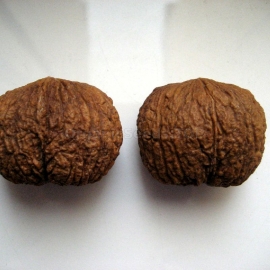


Organic Eastern Black Walnut Seeds (Juglans Nigra)
1.39 €
Juglans nigra, the eastern black walnut, a species of flowering tree in the walnut family, Juglandaceae, is native to eastern North America. It grows mostly in riparian zones, from southern Ontario, west to southeast South Dakota, south to Georgia.
-
Organic Oriental Black Walnut (Juglans Nigra)
Juglans nigra, an oriental black walnut, is a flowering tree species in the Juglandaceae walnut family that is native to eastern North America.
It grows primarily in coastal areas, from southern Ontario, west to southeast South Dakota, south to Georgia, northern Florida, and southwest to central Texas. Wild trees in the upper Ottawa Valley may be an isolated local population or grow from planted trees.
Black walnut is a large deciduous tree reaching a height of 30-40 m (98-131 ft). In conditions of forest competition, it develops a tall, clean trunk; open view has a short trunk and a wide crown. The bark is gray-black, deeply grooved. There are air layers in the core of the branches.
Leaves are alternate, 30–60 cm (12–24 in) long, pinnate, with 15–23 leaflets, the largest of which are located in the center, 7–10 cm long and 2–3 cm wide. Male flowers are drooping earrings 8–10 cm (3.1–3.9 in) long, female flowers are terminal, in clusters of two to five, ripening in the fall into a fruit (nut) with a brownish green semi-soft husk. and brown corrugated walnut.
How to grow
Walnuts are dormant and need a pretreatment known as stratification to enable them to germinate. The nuts should be mixed with a 50/50 mixture of wet peat / compost and sharp sand - just enough to separate the seeds from each other. Place them in a plastic bag (freezer bags are ideal) and place the loosely tied bag in the refrigerator for at least 6 weeks. Check them every week and if they show signs of sprouting, plant them as soon as possible.
After this pre-treatment period, they can be sown into good quality potting compost in deep containers (at least 20 cm deep), covering each nut with a couple of centimeters of soil. in shallow containers will cause severe root deformation. They can be started under shelter or indoors, but from the beginning of summer they really should be placed outside.
They can also be sown in the garden, usually in April, on well-cultivated soil free of perennial weeds. Walnuts are best scattered over the soil, pressed into soft soil by hand or with a roller, and then covered with soil a couple of centimeters. They will need protection from mice, squirrels, pigeons, etc.
Newly emerged seedlings are very vulnerable to late spring frosts and should be protected by wool, straw, etc. Sowing should not be done too early in the spring so that the seedlings germinate after the last spring frost date - usually in May and early June. depending on your location. Initial growth is rapid and within a few weeks of germination, the seedlings will grow 10 to 20 cm in height. To stimulate maximum growth, make sure the trees are never stressed by a lack of water, are well nourished and grown in a warm, sunny location.
Trees should be planted in their permanent location as soon as practicable. If they are large enough, at the end of the first growing season and always at the end of the second. Walnuts produce an impressively strong taproot that is quite soft and fleshy, which is easy to damage when transplanted. After 3 or 4 years, the size of this taproot makes transplanting a challenge!
Newly planted trees should be free from competition from weeds and grass, these conditions will ensure the greatest success when replanting and vigorous growth after planting. A young tree that has a weed-free area of 1 meter in diameter will grow at least 3 times faster than a tree that has serious competition between grass and weed.
